Geddy Lee: Bass Conservator
By Ward Meeker, Vintage Guitar, March 2019, transcribed by John Patuto
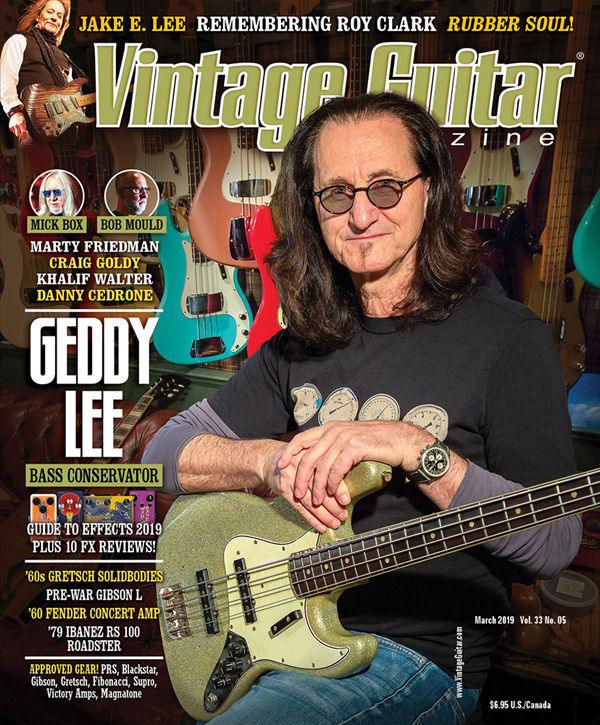
One of the world's top bassists, he melded the influences of Motown, Yes, Zeppelin, the Who, and Cream to help forge the legendary Rush musical catalog. Today, he tends to one of the finest bass collections, and is sharing it all in a beautiful new book.
In its 40-plus years, Rush evolved on its own terms. Mixing rock and jazz influences, the band's 19 studio albums fostered a cultish fan base of prog-rockers, headbangers, and others drawn not only to the music, but the way its three creators - guitarist Alex Lifeson, drummer Neil Peart, and bassist Geddy Lee - followed their hearts and minds while spurning the pressure to record radio hits.
Lifeson and Lee were school chums who played in bands - separate and together - before becoming a trio that solidified with the addition of Peart prior to Rush's second album. The drummer played a dominant role in the band's musical direction; where its 1974 debut was straightforward, Zeppelin-influenced rock, with the highly literate Peart's lyrics and jazz background, the follow-up, Fly By Night, hinted at the style that would earn those decades of adoration - most vitally, elements of progressive rock and sci-fi lyrical themes.
While at first appreciated by a relatively small audience of dedicated followers, Rush persevered to become a pop-culture icon and today sits behind only the Beatles and Rolling Stones for most consecutive U.S. gold or platinum album sales by a rock band. One of the world's top bassists, Lee's musical direction was initially abetted by Motown songs on the radio.
"A lot of that stuck in my head - Supremes songs, James Brown, Wilson Pickett, 'My Girl' and 'In the Midnight Hour' - it all intrigued me," he said. Other pushes came via the Beatles and Beach Boys - and while the California sound was "fun," the British Invasion had more appeal after he started playing guitar.
"By then I was listening with a different mindset," he recalled. "A different set of ears."
His focus turned to bands like the Yardbirds.
"I remember the first time I heard 'For Your Love' and how it just grabbed me," he said. "Same with the riff from Roy Orbison's 'Pretty Woman.'"
The Yardbirds bread-crumbed his path to John Mayall's Bluesbreakers and other blues-rockers. He was 15 when he and Lifeson took the first steps in building the Rush legacy.
We spoke with him as he anxiously awaited the first copies of Geddy Lee's Big Beautiful Book of Bass, a stunning coffee-table tome that not only displays his astounding collection of basses (and guitars), but relates the stories that make them much more than a mere assemblage of wood and wire.
The culmination of more than two years' work, like its author, the book exudes a kid-in-a-candy-store verve derived from overwhelming curiosity and a late-blooming interest in vintage gear.
But we're getting ahead of the story...
When did you get your first guitar?
I think I was 14, when my next-door neighbor had one for sale. It was a lovely acoustic - I don't know the brand, but it had two palm trees painted on it and it was the most beautiful thing; I begged my mother to loan me the $15. The first song I figured out was "For Your Love," and that was a real moment... I thought, "Hey, this is fun."
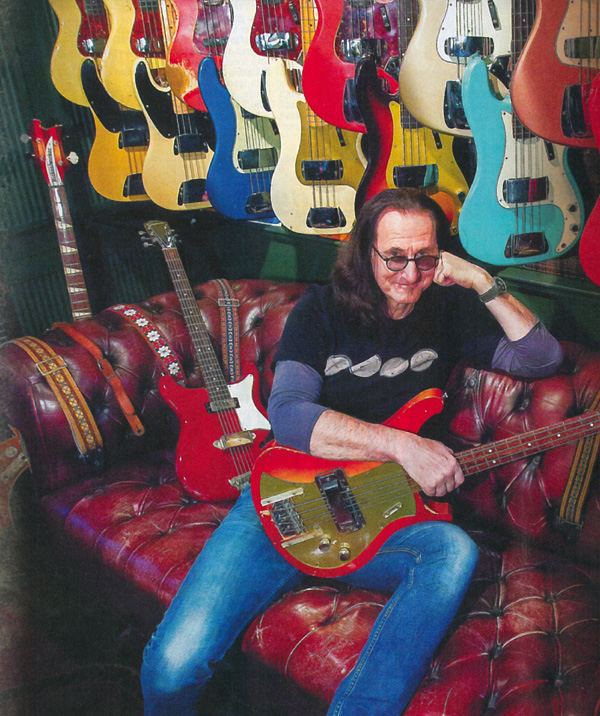
Safe to assume it wasn't long before you were jamming with friends?
Yeah, a couple other guys were just getting into music, so we rehearsed in a friend's bedroom. But the guy playing bass... his mother didn't like him hanging with us, so he was gone. Then they voted that I'd be the bass player. So, Mom loaned me $35 so I could buy one at the music store - a Conora. I didn't have an amp, but I figured out how to plug it in to my hi-fi. That was the holy grail for me - a real electric bass!
Was it a knock-off?
Yeah, it was a P-Bass, Japanese made. Kents and Conoras were common in Toronto back then.
Was it good for learning?
Well, I could figure out parts on it. I was into the Rolling Stones at that time, so I learned "2120 South Michigan Avenue." In the neighborhood, that was a test: If you could play "2120" - or as we called it, "Two-One-Two-Oh," - wow, you could play.
That band went until I met a kid in class named Alex Zivojinovich - the most unpronounceable name - but we became good pals and eventually played together in the earliest incarnation of Rush.
Were you still the frontman/singer?
I kind of was; I did the jobs nobody wanted to do. Nobody wanted to play bass. It's like baseball; nobody wants to be the catcher, so they have to make someone catch. In hockey, nobody wants to be the goalie, they make someone do it. But I could sing, so I did. Even in early Rush, John Rutsey (the band's first drummer) had no singing voice. Alex could sing a bit, but he didn't want to.
What was your first good bass?
That was a '68 Precision. I worked a lot of Saturdays in my family's variety store and saved my money to buy a sunburst Precision. Through high school and bar gigs, that was my workhorse. In the book is a picture of me playing it; the finish was pretty worn by the mid '70s, but I played it until I got my first record deal and eventually turned it into my Space Bass.
Was the Rick 4001 next?
Yes. When we got an advance from Mercury Records, the first thing Alex and I did was go to Long and McQuade, here in Toronto. By that time, I was a huge Chris Squire fan, so I had to have a Rickenbacker 4001. They had a bunch on the wall, and I picked the black one and a Sunn 2000S amp with two twin 15" cabinets. I was a rock star then (laughs)! My big splurge. I had a Ricky and Sunn, just like the big boys.
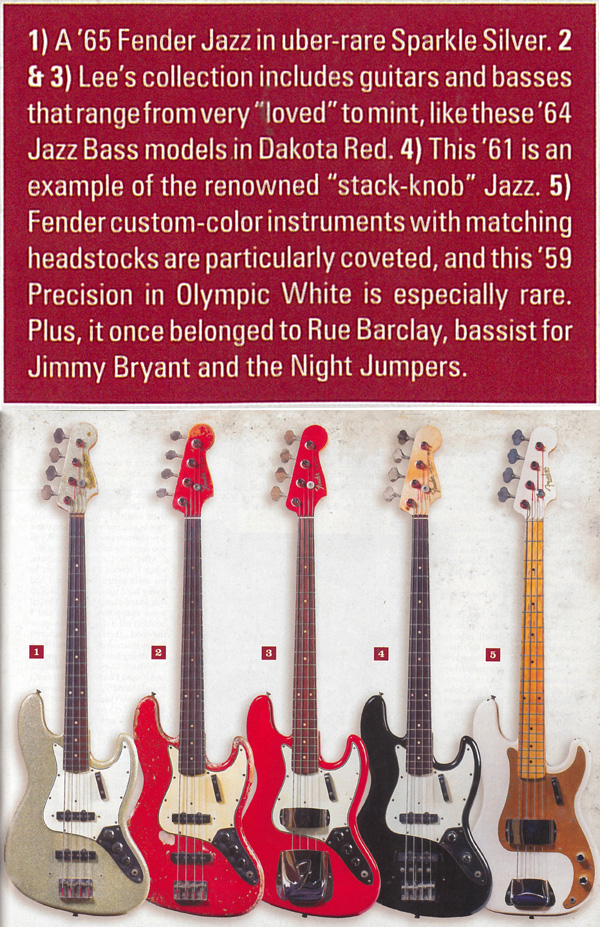
Did the sound and feel of the Rick change the way you played?
Well, I spent a lot of time trying to make it sound like Chris Squire. Strangely, it didn't (laughs). I didn't yet realize that a player's sound comes from their fingers, not from the instrument or amplifier. I'd crank up the top-end and get it twangy, and woodshed as often as I could, trying to play Yes songs that were beyond me at the time. I'd get moments, but not the whole thing. I was also a big fan of Jack Bruce at that time, along with John Entwistle and Jack Casady. Those were the guys I was mimicking as I was becoming more professional.
Did you modify it?
Yes, after a time I had trouble with the slimline Grover "exploding" tuners, so we put on different Grovers. Also, I had trouble intonating in the studio and was a little frustrated by the bridge. Plus, I was looking for more sustain. Someone suggested the Leo Quan Badass bridge, and I loved it with the Ricky's sound; I sensed it gave me a bit more sustain, and the intonation was much more accurate. I play with roundwound strings, and Rickenbackers don't love them; we had to adjust the neck a lot, and dress frets because I'm pretty hard on basses. But the Quan bridge really did help, and as a rule we put them on everything.
It made such a marked improvement?
Yeah, and of course I figured they had to help everything, but I wasn't in a position to A/B. For years, I bought what I needed as a tool, you know? Whatever served my sound. As we got more successful, people would try to give me basses, but if they didn't slot into my sound, it was like, "Thanks, but I'm good." There's a picture of me from the late '70s with my collection - all six instruments sitting in a tune-up room.
That was one of the thrills with this book - the opportunity it afforded me to learn so much about an instrument I had taken for granted. And to dispel myths. When you have the very fortunate opportunity to play every Jazz Bass from 1960 through to '73, and play them over and over, A/B them side by side, you really get to understand how the instrument developed, and you sense the minute differences.
After the Counterparts album, when I started using the Jazz as my main instrument again, I had a very hard time finding a backup that sounded exactly like it. I found some that sounded close, and I couldn't tell if it was the pickups or the wood... there's a bit of witchcraft in any instrument, and sometimes everything just was right.
With my '72, everything was right, and it wasn't until years later that I found a blond '72 for sale. I thought, "Well, I don't have a blond one from that year. Let's see how it sounds."
The day it arrived, I was working on a track for a young band that had asked me to play something. So, I plugged it in, and it sounded so close to my number one. It was the thing I'd been looking for 10 years. It's a fantastic instrument, and the heaviest of the '70s Jazzes I own, by a long shot.
Where does your right-hand technique come from? So many notes mostly from one finger, like James Jamerson on those Motown songs you heard as a kid.
It depends. If I'm playing double-time or triplets or something, I'll also use the index finger. But yeah, I use one finger for a lot of things. I don't know exactly when - the mid '80s, I think - I started developing this more-rhythmic technique because I never felt comfortable with a pick. I didn't like the feel of it in my hand, but I liked the strumming vibe of a pick. So, I picked up a flamenco attitude, and I could get that sound without a pick. That was when slapping and popping were in, and all these pyrotechnics were becoming part of a bass player's tool kit. I would do some of that - "Big Money" has a lot of popping - but I never felt comfortable slapping. I went another direction and tried to keep it more rock-and-roll, more aggressive. I still wanted to identify it as a "hard rock" bassist, though I'd been influenced by jazz and other, more-rhythmic players. I'm always at home as a rock player - and as such, I needed to use of all my fingers, especially for some of the faster stuff.
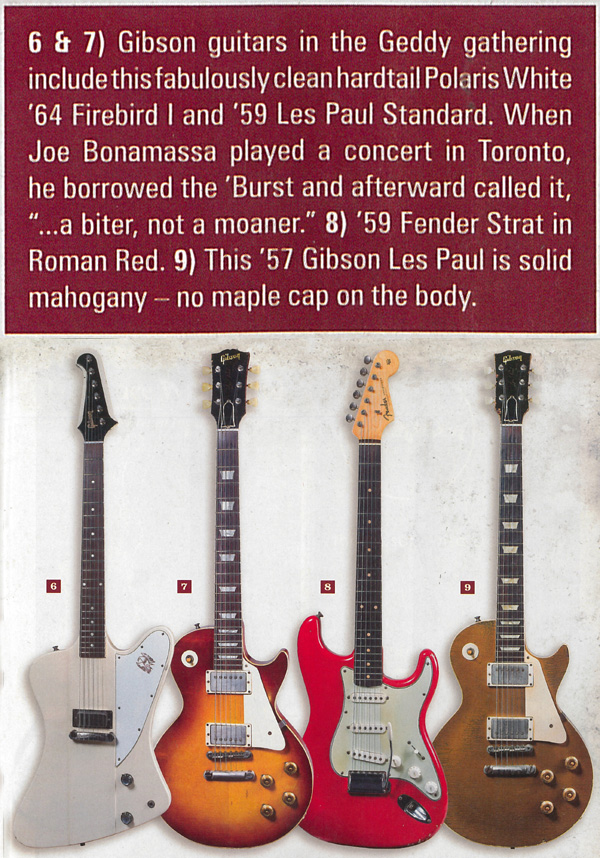
How about your left hand?
It just does what it's told (laughs).
But is it more Chris Squire than Jack Bruce when it comes to bending a note or doing a slur or hammer-on?
I never really thought about my left hand, to be honest because it's just a slave. It finds the notes. The right hand creates your sound and makes it come alive, right?
The key thing for a young bass player to focus on is making that right hand work for you. Just have faith that the left hand will get you to where you need to go. The left hand is more directly connected to your brain in terms of musicality and choice of notes. But the way it speaks is all about your right hand.
Did you have parameters when you started collecting basses?
I started when I did a swap with a music store - one of my backups in exchange for a couple of vintage basses. The idea of owning vintage basses had never really occurred to me until that deal. I thought, "Well, it would be cool to have a bass from my birth year," because wine collectors always look for wines from their birth year. It's a collector's conceit. And because the Fender bass began in '51, I thought a '53 would be a nice early example. So, I got a '53 Precision and a '68 Paisley Red Tele Bass at the same time. The tones from both were interesting, and the Precision was bringing me back to my roots. Then, Skully and I (Ed. Note: That's John "Skully" McIntosh, Lee's instrument tech and good friend) said, "It would be fun to get more!" And when collectors say that (laughs), they're done for; "Wouldn't it be fun to have iconic basses from the players I admired growing up? An EB-3 like Jack Bruce played, a Höfner Cavern from early '61 like Paul McCartney played..." So, we started looking. It's dangerous when I start thinking like that - and here I am, 250 basses later.
Is it dangerous because you're impulsive?
It's not the impulsiveness, it's the obsessiveness. Once I start, I want to know. I'm curious. Looking at a '53 Precision, I think, "What does it sound like? How did it come to be?" And that requires research, investigation, and context. I need to know "How did it go from '51 to '53 to '55 to '58 to '61?" Play a '62 next to a '69 and they feel quite different. I always want to know "Why?"
Anyway, when I started really looking into instruments, I felt a bit foolish, like, "I've been playing professionally for over 40 years and never played an EB-0 in any serious manner. I never really played a Thunderbird, or any Höfner basses. What did I miss? Then I started finding examples and comparing them, seeing what my fingers do, with each. That's how it began.
As each arrives, do you spend a couple hours with it?
Yeah. Skully and I have a discussion on what it needs, then he takes it home to put on the strings I use and set it up in a way I can play it. Some of them are so mint that I don't touch them, and if it's not an instrument I plan on using in any serious way, I'll leave the original strings on and just let the thing live happily. Still, I like to hear what they sound like, so Skully cleans them up, sets up the bridge, then brings it back.
The most fun is when we sit in the studio and A/B an instrument. We compare it with the year before and the year after. Or, if we have a few from the same year, we compare them: "Is this a good one? What's the difference in sound?"
I sometimes buy basses just because they're beautifully made and look amazing. I'm also a completist - I like to fill every gap and tell a story. I focused on the first 20 years and wanted examples from all kinds of manufacturers, even obscure Italian builders - and some of those are very difficult to play or use in a practical way, but I'm content to have them as wall-hangers.
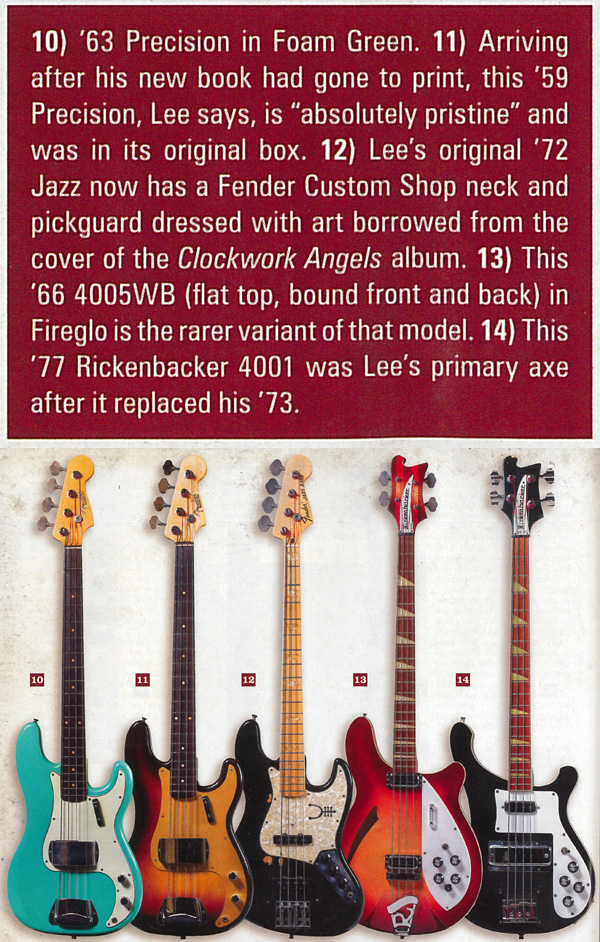
Were there pleasant surprises in terms of playability or sound?
The early Höfners were a revelation. In the book, I tell the story of rehearsing for the R40 tour in L.A. and a dealer from whom I'd bought a few things had just got a big collection of Höfner instruments. So we went to see them, nicely displayed in his living room. Early Höfners were really beautifully crafted instruments - the company made violins and double basses, and you could see an attention to detail that Leo Fender would have considered superfluous. I was drawn to touches like the arched tops and shape of the soundholes - sometimes they look like birds or seals, and the purfling has detail they didn't have to put into the instruments, but obviously wanted.
Anyway, he had an early set-neck model 182, and I'd never seen one; it's a solid bass from '61. I said, "Do you mind if I take this to rehearsal?" Because I was so curious about how it would sound. It played a little like a toy - the neck was almost too narrow. But I plugged it in, and man... its bottom-end just was shocking. Thunderous. At the time, there was this spot at the very end of the show where we were playing "What You're Doing," and I thought, "I have to use it in that song," because I knew the room would just vibrate from all the bottom-end. It was fun.
I then got a little carried away learning about Höfner basses. Between '56 and '67 they changed incrementally - even within a single year they'd change pickups, pickup placement, and set necks would become bolt-on necks. Some had certain tuning pegs because Selmer wanted their own specs, so you have the Selmer instruments and the German instruments, and we'd find them all over Europe. It became a marvelous hunt. And who pays attention to that stuff? Only an uber nerd (laughs). But I allowed myself to geek out, and learned a lot about the music world from the 1950s through '75.
Is the Ampeg Devil Bass a good player?
A good player (chuckles)? I would say it's an unusual player. The Devil and Ampeg's scroll basses are some of the most unusual instruments. They have a tone all their own, no question, and they're not difficult to play, but those big necks and the long, uninterrupted span of strings... I tried to use them live, but couldn't. I think they'd be great for a combo that plays jazz, where you don't have to fight with volume, but, not the best for a loud hard-rock band [because] the pickups are quite microphonic. I love the way they look, and the history of the company is really interesting. They photograph beautifully - they're such strange-looking beasts.
Speaking of strange-looking beasts, how many Wandres do you have?
Only four Wandre basses - they're harder to find. But I have quite a few Wandre guitars. I think they're really incredible pieces of art when they were made, and he was so avant-garde for the late '50s, early '60s. There he was, working away in this little town in Italy. He built a round factory - really post-modern - to produce these instruments. It was quite bold.
How did Wandre Pioli fare as a luthier versus an artist?
Well, his fit a concept where it's one piece of metal and the plastic and wood parts sit on it. But he was trained as a luthier and his double basses sound good; they're quite practical. I'm not a double-bass player, so I couldn't tell you how they compare to a classic double bass, but the one I have sounds good.
You also have a striking red bass with a short scale...
It's a remarkable-looking bass. It's a bit awkward to play, but the guitars have a very "Django Reinhardt" vibe.
In the book, you write about being drawn to sparkle finishes. What's the attraction?
Growing up, I used to think they were cheesy. But through the collecting I've realized how rare some are, especially Fender sparkle instruments. So I've got a new appreciation for shiny objects (laughs).
You have a handful of sparkle-finish Hagstroms, including a green DeLuxe "Batman." How does it feel and sound?
It's actually quite nice to play. Like some of the early Höfners, Hagstroms tend to feel a little toy-like, but the Batman is the best of them. They're decent-sounding; DeLuxes have a tone of their own. Are they a hardcore rock instrument? I don't know, but their history, the push buttons, and the sparkle shows the connection with making accordions in the late '50s and early '60s. That always struck me as funny - but obvious and practical - the way they branched out to guitars using some of the same parts.
I had a Hagstrom many, many years ago when I was finding out who I was as a bass player. It had a really thin neck, was easy to play, and sounded good. So, I've always had a fondness for them.
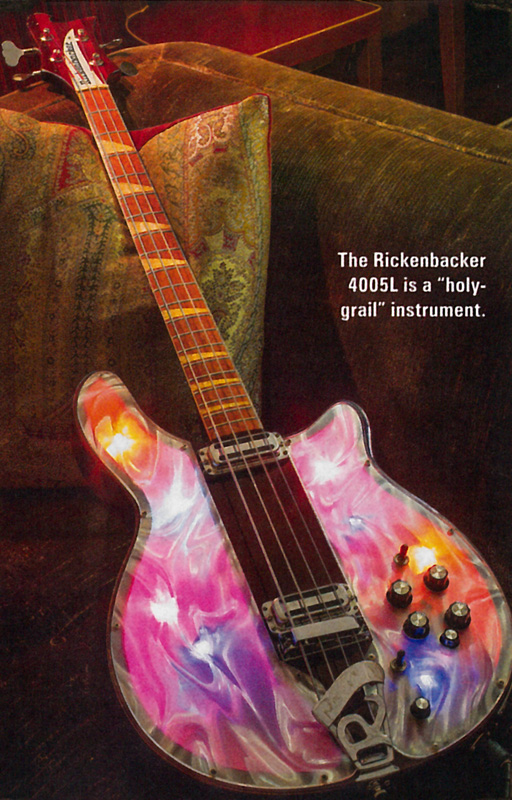
One of rare gems of your collection is a Rickenbacker 4005L Lightshow. How does it compare to a 4001?
It's a bigger, clunkier 4001. And let's face it, it's a showpiece. It sounds like a 4005 - kind of bottomy. You can get top-end out of them, but you got to work at it. And yeah, it has that semi-acoustic vibe even though it's chock full of all the wiring and the lighting apparatus. They play more like a 4005WB, with the squared-off body, but even thicker.
It's such a curiosity...
It is. And I don't know how the guy who played mine all those years got one, but I assume he played in a country band; in the book, I have a picture of him playing in a juke joint. The book also has a nice conversation with John Minutaglio, a friend and big collector of Rickenbacker stuff. Wherever my knowledge was lacking, I tried to find someone to add insight and he was a terrific resource on Rickenbacker.
How long did you look for it?
I never thought I'd find one, to be honest. As a collector, there's certain holy-grail instruments. So, when it came available, I jumped. Collections must be fed. That's the way I think. If you're not feeding a collection, it stagnates, and if you're a completist like I am, you want those missing pieces. That was a big one, and I'm thrilled to have it.
Which instruments have given you the biggest thrill when they arrived?
Any '62 Jazz is a huge find, especially an original custom color. As a "mental collector," the first Jazz I bought was a '62, and I got it because players and collectors point to '62 as being the best of the early pre-CBS period. So I found a refin - it's not a very accurate Sea Foam Green, but I didn't care. I plugged it in and everything they say about the '62 Jazz was true. It's a monster. Put against any other Jazz, the pickups are hotter and the electronics are more vibrant. It's ballsier than a lot of the other vintages; '63 was very good, '64 was very close. But there's a substantial difference between the stack-knobs and the three-knobs. There's a bit of magic. Every time a '62 gets near me, I get very, very excited.
Obviously, the Light Show is in that category. The expression "Go find another" really excites collectors.
How about favorites from other builders?
I have a wonderful collection of Gibson Thunderbirds, and amongst them is a Frost Blue that is probably my favorite, and it's all-original and sounds great. I have a Pelham Blue Firebird I love, and they're really hard to find. Opening those cases was very exciting. Non-reverse Firebirds in custom colors are hard to find, too, but a reverse custom-color in good shape without a neck repair...
Had you played a Thunderbird before?
I poo-pooed Thunderbirds for years. Pete Watts played one in Mott the Hoople, and Pete Way from UFO played one. I toured with both those guys, and I didn't get it. The sound was a bit too woolly for me. But, I brought a couple on the last Rush tour and learned a lot about their tone; which is different from an EB-0 or any other Gibson solid body; the pickups have a very interesting midrange and upper-low-end, with a bump that fits right between the guitar sound and kick drum. I tried them on a couple songs and they worked well because even though I lost some of the twang I get from a Jazz or Rickenbacker, they provide a volume and range that worked to my advantage.
There's also one in Cardinal Red.
That's a beauty, too. That one had a neck repair; there was a small crack in the back of the headstock, but I bought it because it's so rare. It really plays well.
How about the Höfner Cavern?
Caverns with the exact specs Paul McCartney ordered in that shop in Hamburg were only made for four months, which makes it monumentally hard to find. I first bought one that turned out was made later in the same year, with the headstock slightly longer. When they changed from the early-'61 "floral" logo on the headstock, they went to a horizontal script logo. At that point, there's a significant difference. In the book, I explain the minutiae.
Most people who have a true Cavern don't want to part with it, and the guy I found did because there was overspray on the top. We refinished that section to make it look right. It's not a perfect Cavern, but it's a Cavern - 100 percent authentic from the period when McCartney bought his original.
Your sparkle-finish '65 Jazz is super-rare.
That is an amazing instrument. I was very happy to find it from a gentleman in Bakersfield, California. It seems like every time someone tries to sell a sparkle-finish Fender, they claim that it has some sort of kinship with the Buckaroos.
Especially coming out of Bakersfield.
Exactly. The guy said it once belonged to Doyle Holly, but Doyle played maple fret-boards, this has rosewood. It also has a couple of strange features like earlier tuning pegs and a bound neck. But it really plays nicely.
I appreciate Fender sparkle instruments more because they were a true custom order. It wasn't like ordering a custom color, because Leo didn't have accommodations to do sparkle stuff in his shop, so they'd send them to auto-body shops. That makes them the rarest of the rare. And they're fun to look at.
When did you start conceptualizing the book?
When I started hearing the stories behind the instruments and thinking about some of the weird places we'd find them. I love to know provenance and get pictures of the people who originally owned them. Wherever I can in the book, I put them in. They're interesting, they're archeological, and need to be remembered.
When I started looking at bass books to use as a reference, I found there are a lot, but there wasn't a nice compendium for players who love vintage basses. I saw a need and thought "I should do that." It percolated for a couple years, then I started to act on it once I was achieving critical mass with the collection.
Book of Love
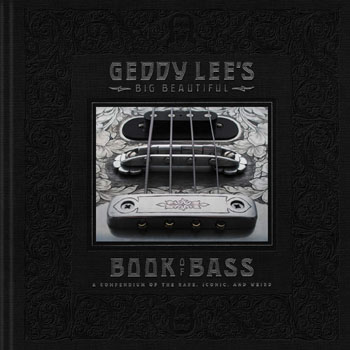
Nearly two years in the making, Geddy Lee's Big Beautiful Book of Bass: A Compendium of the Rare, Iconic, and Weird features players and collectors discussing their connection to iconic instruments. Lee began collecting in 2010, and became a de facto instrument historian as his gathering grew to 250 pieces. The book shares what he learned and discusses examples ranging from player-grade road warriors to "closet queens" that emerge after not being touched for decades. Other perspectives come courtesy of John Paul Jones, Bill Wyman, Bob Daisley, and others along with names familiar in the collecting realm including Fender expert Ken Collins and veteran tech Alan Rogan. Together, they offer insight on revered gems by Fender, Gibson, Rickenbacker, Höfner, and Ampeg along with instruments made by less-celebrated but nonetheless vital names like Wandre Pioli, Dan Armstrong, and Tony Zemaitis.
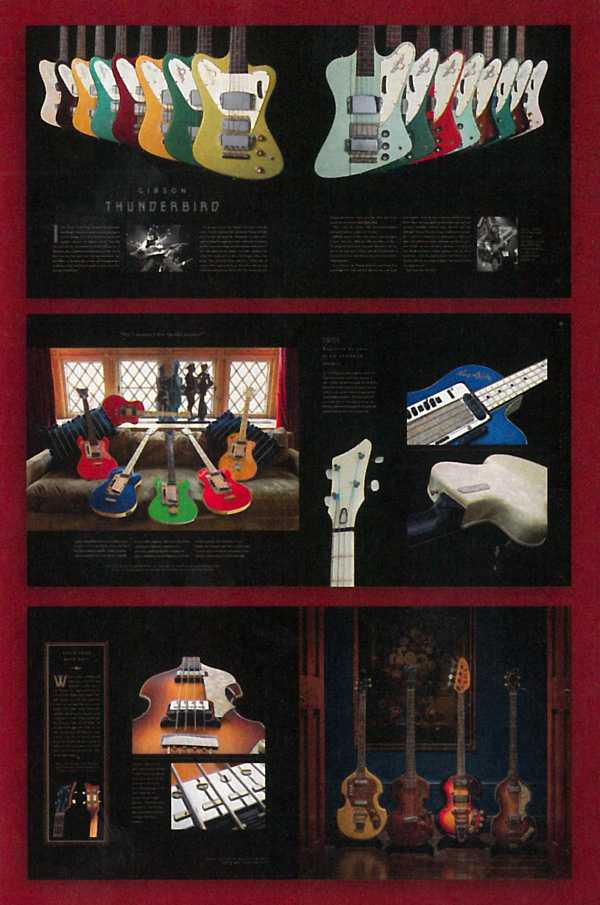
The photos were shot by Richard Sibbald over a period of 18 months, almost all at Lee's home and, he points out, "Thanks to my incredibly tolerant wife, who gave up her art studio."
Production began with 30,000 photographs, and an early draft was nearly 650 pages, which Lee said was unrealistic in part because he wanted black pages, which meant thicker paper to accommodate the ink.
While paring photos, Lee spent two weeks with a designer at Harper Collins, "...basically punching the clock every day and sitting in a cubicle" until they'd chosen just over 1,000 and created a draft of manageable size.
"But even at 408 pages, you don't want to drop it on your foot!" Lee said.
The end result is a new standard amongst guitar-collection books, fully exhibiting Lee's astonishing passion for the instruments and the task of tracing their provenance.
"I'm really proud of it," he said. "I worried it to death and a lot of people sweated over it. But it's the book I set out to make."
As with his other interests, wine and baseball memorabilia, Lee revels in the "club" aspect of collecting.
"One's hobbies make the world a bigger, more-interesting place," he said. "They're a window to the things that fill you up and make you a more-interesting person."